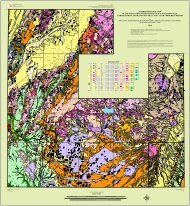Annual review and forecast of Utah coal - Utah Geological Survey ...
Annual review and forecast of Utah coal - Utah Geological Survey ...
Annual review and forecast of Utah coal - Utah Geological Survey ...
You also want an ePaper? Increase the reach of your titles
YUMPU automatically turns print PDFs into web optimized ePapers that Google loves.
<strong>Annual</strong> <strong>review</strong> <strong>and</strong> <strong>forecast</strong> <strong>of</strong> <strong>Utah</strong> <strong>coal</strong> production <strong>and</strong> distribution—2009 19<br />
<strong>and</strong> 648,000 tons delivered in 2001. The recent large<br />
swings in total residential <strong>and</strong> commercial <strong>coal</strong> deliveries<br />
are partly due to changing reporting methods, <strong>and</strong> purchases<br />
by commercial <strong>coal</strong> brokers. Commercial brokers<br />
buy <strong>and</strong> sell substantial amounts <strong>of</strong> <strong>coal</strong> each year, with<br />
most <strong>of</strong> their volumes going to utilities for power generation.<br />
These transactions may be logged as commercial<br />
deliveries, but are probably not going to homes or businesses.<br />
There is little market evidence <strong>of</strong> <strong>coal</strong> use by businesses<br />
<strong>and</strong> residences in <strong>Utah</strong>. Approximately 20 wholesale <strong>and</strong><br />
retail outlets for <strong>coal</strong> have been identified in the state, but<br />
these sources have dwindled in number, <strong>and</strong> few proprietors<br />
report useful customer information, except to say<br />
that a few customers, mostly in rural areas, continue to use<br />
<strong>coal</strong> as a backup fuel or for decorative fireplaces. In addition,<br />
a few tons <strong>of</strong> Pennsylvania anthracite <strong>coal</strong> is distributed<br />
in <strong>Utah</strong> <strong>and</strong> nearby states as boutique fuel. Due to the<br />
expansion <strong>of</strong> natural gas pipeline networks, there are only<br />
a few remote locations in <strong>Utah</strong> where <strong>coal</strong> still competes<br />
favorably with propane, electricity, or renewable sources<br />
<strong>of</strong> energy for residential <strong>and</strong> commercial applications.<br />
Foreign Exports<br />
Dem<strong>and</strong> for <strong>Utah</strong> <strong>coal</strong> by foreign countries peaked in the<br />
early 1980s <strong>and</strong> again in the mid-1990s, reaching a record<br />
5.5 million tons in 1996, matching peaks in both production<br />
<strong>and</strong> total distribution (table 8). Through 2003, as deliveries<br />
dwindled to 222,000 tons, all exported <strong>coal</strong> went to<br />
Asian markets. In 2004, 295,000 tons <strong>of</strong> <strong>Utah</strong> <strong>coal</strong> went to<br />
Canadian markets, followed by 212,000 tons in 2005 <strong>and</strong><br />
only 34,000 tons in 2006. Exports increased again in 2007<br />
<strong>and</strong> 2008 as companies reported that a total <strong>of</strong> 173,000<br />
<strong>and</strong> 312,000 tons <strong>of</strong> <strong>Utah</strong> <strong>coal</strong> went to Canada, Mexico, <strong>and</strong><br />
Korea. No <strong>Utah</strong> <strong>coal</strong> was reported to have been shipped to<br />
other counties in 2009.<br />
COAL IMPORTED INTO UTAH<br />
Coal imports into <strong>Utah</strong> increased 67.0% in 2009 from 2.5<br />
million tons in 2008 to 4.2 million tons in 2009 (table<br />
13). In previous years, the vast majority <strong>of</strong> imported <strong>coal</strong><br />
(roughly 2 million tons a year) went to the Bonanza power<br />
plant in eastern <strong>Utah</strong>, which primarily uses <strong>coal</strong> from a<br />
company-owned mine in Colorado. However, the IPP <strong>coal</strong>fired<br />
power plant imported 1.9 million tons <strong>of</strong> Wyoming<br />
<strong>coal</strong> in 2009, nearly doubling <strong>Utah</strong>’s total <strong>coal</strong> imports, <strong>and</strong><br />
plans to import 1.4 million tons in 2010 (table 10). Holcim<br />
<strong>and</strong> Utelite, two <strong>Utah</strong> industrial users, also import minor<br />
amounts <strong>of</strong> <strong>coal</strong> from out-<strong>of</strong>-state.<br />
Table 13. <strong>Utah</strong> <strong>coal</strong> imports, 1981–2010.<br />
Thous<strong>and</strong> short tons<br />
Year<br />
Electric<br />
Utilities<br />
Coke<br />
Plants<br />
After a relatively successful year in 2006, when <strong>coal</strong> production<br />
totaled 26.1 million tons, <strong>Utah</strong>’s <strong>coal</strong> industry has<br />
suffered a few setbacks due to mine closures <strong>and</strong> difficult<br />
mining conditions, dropping production to 24.3 million<br />
tons for both 2007 <strong>and</strong> 2008. With the 2009 closure <strong>of</strong> the<br />
Bear Canyon mine, <strong>and</strong> low dem<strong>and</strong> due to the economic<br />
recession, <strong>Utah</strong>’s total <strong>coal</strong> production for 2009 dropped<br />
to 21.9 million tons, the lowest level since 1993. With dem<strong>and</strong><br />
slow to recover, <strong>and</strong> with several mines facing difficult<br />
conditions, production for 2010 is estimated to drop<br />
below 20 million tons (19.1 million tons) for the first time<br />
since 1988. On a more positive note, after a 10-year effort<br />
to secure the necessary permits, <strong>Utah</strong>American Energy<br />
has finally begun construction on the Lila Canyon mine.<br />
The rock slopes were completed in the spring <strong>of</strong> 2010<br />
<strong>and</strong> development in the <strong>coal</strong> bed started shortly thereaf-<br />
Industrial<br />
Res./<br />
Com.<br />
OUTLOOK FOR UTAH’S COAL INDUSTRY<br />
Total<br />
1981 8 1,030 98 0 1,136<br />
1982 18 695 84 0 797<br />
1983 0 854 83 0 937<br />
1984 224 1,229 85 1 1,539<br />
1985 193 1,289 98 0 1,580<br />
1986 659 383 103 0 1,145<br />
1987 905 160 100 0 1,165<br />
1988 1,300 1,088 60 0 2,448<br />
1989 1,400 922 45 0 2,367<br />
1990 1,449 679 7 2 2,137<br />
1991 1,310 695 2 0 2,007<br />
1992 1,517 629 9 0 2,155<br />
1993 1,501 579 20 0 2,100<br />
1994 1,495 1,089 4 0 2,588<br />
1995 779 1,062 0 0 1,841<br />
1996 805 1,120 0 0 1,925<br />
1997 1,509 1,106 0 0 2,615<br />
1998 1,733 982 0 0 2,715<br />
1999 1,431 728 0 0 2,159<br />
2000 1,531 936 0 0 2,467<br />
2001 2,028 648 0 0 2,676<br />
2002 2,074 0 16 0 2,090<br />
2003 2,036 0 0 0 2,036<br />
2004 3,021 0 185 0 3,206<br />
2005 2,776 0 10 0 2,786<br />
2006 1,890 0 38 0 1,928<br />
2007 1,428 0 68 0 1,496<br />
2008 2,464 0 49 0 2,513<br />
2009 4,145 0 52 0 4,197<br />
2010* 3,333 0 38 0 3,370<br />
Source: UGS <strong>coal</strong> company questionnaires<br />
*Forecast

















